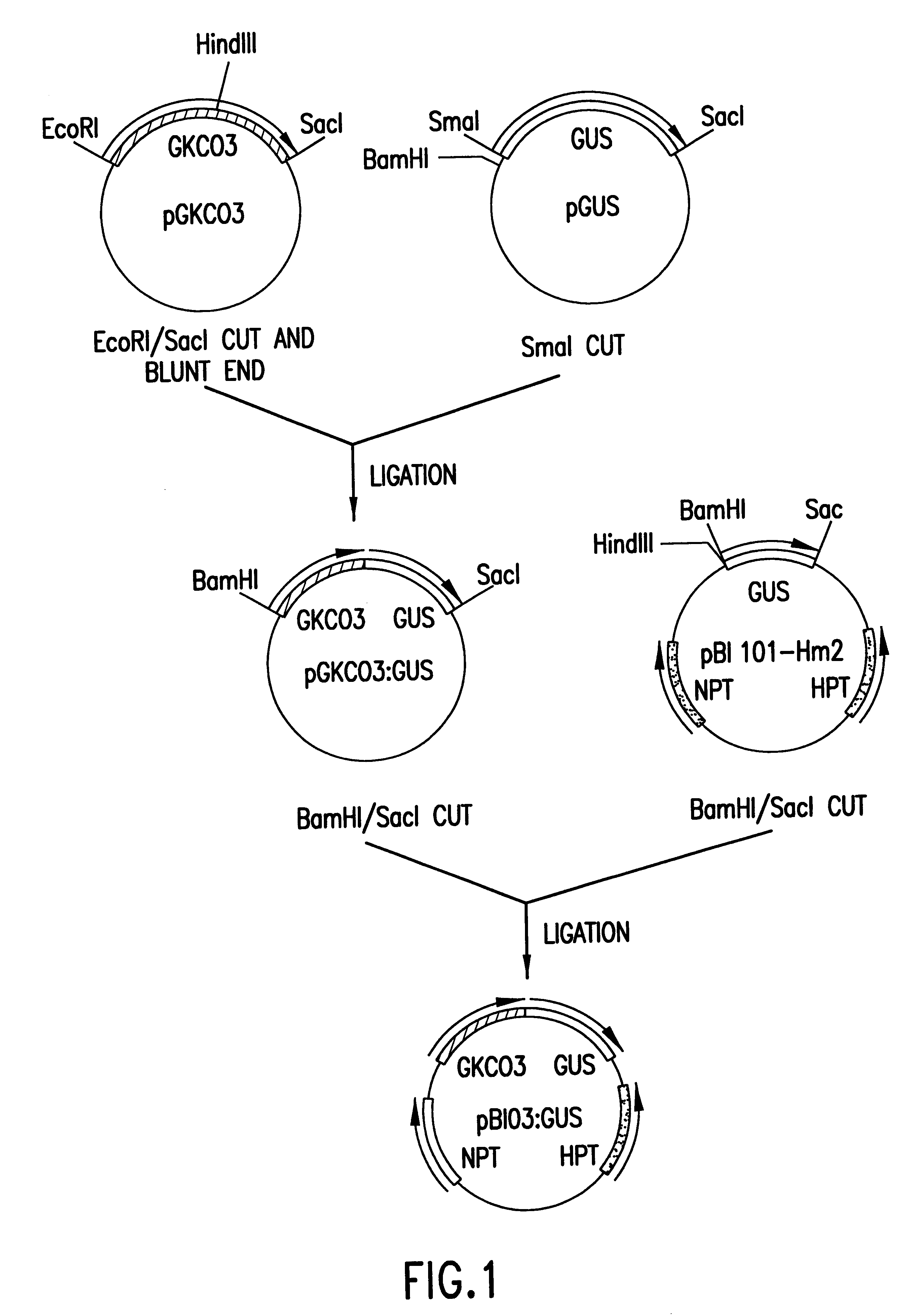Cotton plant promoters
a technology of plant promoters and promoters, which is applied in the field of plant promoters, can solve the problems of unsatisfactory improvement of fiber characteristics, related genes or promoters have not yet been clearly revealed, and the mechanism of cotton fiber formation and elongation has not yet been fully elucidated, so as to improve the yield of cotton fibers, and improve the quality of cotton fibers
- Summary
- Abstract
- Description
- Claims
- Application Information
AI Technical Summary
Benefits of technology
Problems solved by technology
Method used
Image
Examples
example 1
(1) Cloning of Upstream Region (GKC03) for Cotton Fiber Tissue-derived Gene KC03
The seedlings on the 18th day after the seeding of a cotton plant of the genus Gossypium were used to extract genomic DNA by an improved method of Murray and Thompson. The extracted genomic DNA was cloned by the inverse PCR method.
First, 1 .mu.g of the genomic DNA was digested with restriction endonuclease Eco RI, and the resulting fragments were self-ligated with T4 ligase. Then, 500 .mu.g of the ligated DNA was used as a template for the amplification of the upstream region for KC03 (hereinafter referred to as GKC03) with a PCR reagent kit (LA-PCR kit, Takara Shuzo, Co., Ltd.). The reaction was effected with the first group of primers having the respective nucleotide sequences of SEQ ID NOs:2 and 3, and the steps of PCR at 94.degree. C. for 15 seconds and at 65.degree. C. for 12 minutes were repeated in 28 cycles. The PCR products were used for the subsequent PCR with the second group of primers having...
example 2
(1) Cloning of Upstream Region (GKC18) for Cotton Fiber Tissue-derived Gene KC18
The seedlings on the 18th day after the seeding of a cotton plant of the genus Gossypium were used to extract genomic DNA by an improved method of Murray and Thompson. The extracted genomic DNA was cloned by the inverse PCR method.
First, 1 .mu.g of the genomic DNA was digested with restriction endonuclease Hind III, and the resulting fragments were self-ligated with T4 ligase. Then, 500 .mu.g of the ligated DNA was used as a template for the amplification of the upstream region for KC18 (hereinafter referred to as GKC18) with a PCR reagent kit (LA-PCR kit, Takara Shuzo, Co., Ltd.). The reaction was effected with the first group of primers having the respective nucleotide sequences of SEQ ID NOs:7 and 8, and the steps of PCR at 94.degree. C. for 15 seconds and at 65.degree. C. for 12 minutes were repeated in 28 cycles. The PCR products were used for the subsequent PCR with the second group of primers havi...
example 3
(1) Cloning of Upstream Region (GKC22) for Cotton Fiber Tissue-derived Gene KC22
The seedlings on the 18th day after the seeding of a cotton plant of the genus Gossypium were used to extract genomic DNA by an improved method of Murray and Thompson. The extracted genomic DNA was cloned by the inverse PCR method.
First, 1 .mu.g of the genomic DNA was digested with restriction endonuclease Hind III, and the resulting fragments were self-ligated with T4 ligase. Then, 500 .mu.g of the ligated DNA was used as a template for the amplification of the upstream region for KC22 (hereinafter referred to as GKC22) with a PCR reagent kit (LA-PCR kit, Takara Shuzo, Co., Ltd.). The reaction was effected with the first group of primers having the respective nucleotide sequences of SEQ ID NOs:12 and 13, and the steps of PCR at 94.degree. C. for 15 seconds and at 65.degree. C. for 12 minutes were repeated in 28 cycles. The PCR products were used for the subsequent PCR with the second group of primers ha...
PUM
 Login to View More
Login to View More Abstract
Description
Claims
Application Information
 Login to View More
Login to View More - R&D
- Intellectual Property
- Life Sciences
- Materials
- Tech Scout
- Unparalleled Data Quality
- Higher Quality Content
- 60% Fewer Hallucinations
Browse by: Latest US Patents, China's latest patents, Technical Efficacy Thesaurus, Application Domain, Technology Topic, Popular Technical Reports.
© 2025 PatSnap. All rights reserved.Legal|Privacy policy|Modern Slavery Act Transparency Statement|Sitemap|About US| Contact US: help@patsnap.com

